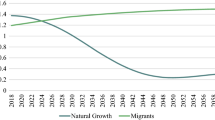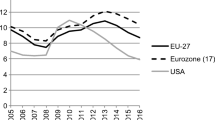Abstract
This paper analyzes the relationship between the international immigration rates and the unemployment rate in Spain for the period 1981–2016. During this period, immigration and employment grew rapidly, but in 2008, the Spanish economy collapsed with a significant increase in unemployment. This paper shows that, due to the characteristics of the migration policy in Spain, unemployment and immigration are cointegrated and, in addition, immigration causes unemployment. This causal relationship is positive, in the sense that the greater the immigration, the greater the unemployment. Last but not least, we find a positive long-term relation between immigration flows and GDP per capita growth.




Similar content being viewed by others
Notes
The SEATS/TRAMO software has a facility to detect the outliers and to remove their effects.
References
Aguilera Izquierdo, R. (2007). El acceso de los immigrantes iregulares al mercado de trabajo: Los procesos de regularización extraordinaria y el arraigo social y laboral. Revista del Ministerio de Trabajo y Asuntos Sociales, 63, 175–195.
Amuedo-Dorantes, C., & de la Rica, S. (2013). The immigration surplus and the substitutability of immigrant and native labor: evidence from Spain. Empirical Economics, 44(2), 945–958. https://doi.org/10.1007/s00181-011-0534-4.
Arango, J. (2013). Exceptional in Europe? Spain?s experience with immigration and integration. Report March, Migration Policy Institute, Washington, DC.
Arce, R., & Mahia, R. (2013). An estimation of the economic impact of migrant access on GDP: the case of the madrid region. International Migration, 51 (1), 169–185. https://doi.org/10.1111/j.1468-2435.2010.00641.x.
Beaulieu, J., & Miron, J. (1993). Seasonal unit roots in aggregate U.S. data. Journal of Econometrics, 54, 305–28.
Berry, J. (1997). Immigration, acculturation, and adaptation. Applied Psychology, 46(1), 5–34. https://doi.org/10.1111/j.1464-0597.1997.tb01087.x.
Bleaney, M. (2005). Migration and unemployment in an efficiency wage model of a small open economy. Economics Bulletin, 6(21), 1–6.
Boubtane, E., Coulibaly, D., Rault, C. (2013). Immigration, unemployment and GDP in the host country: bootstrap panel granger causality analysis on OECD countries. Economic Modelling, 33, 261–269.
Box, G., & Tiao, G. (1975). Intervention analysis with applications to economic and environmental problems. Journal of the American Statistical Association, 70 (349), 70–79.
Caminero, E., & Díaz-Emparanza, I. (1997). Estimation and testing of cointegration relationships with strongly seasonal monthly data. Kybernetika, 33(6), 607–631.
Card, D., Dustmann, C., Preston, I. (2012). Immigration, wages, and compositional amenities. Journal of the European Economic Association, 10(1), 78–119. https://doi.org/10.1111/j.1542-4774.2011.01051.x.
Casares, M., & Vázquez, J. (2016). Why are labor markets in Spain and Germany so different? Documentos de Trabajo 1602, Departamento de Economía - Universidad Pública de Navarra, Iruña, Spain.
Chamunorwa, W., & Mlambo, C. (2014). The unemployment impact of immigration in south africa. Mediterranean Journal of Social Sciences, 5(20), 2231–2640.
Chang, H.C. (2014). Do guest workers rob jobs? a case study of Macau. Journal of Chinese Economics, 2(2), 21–38.
Chang, W. (1979). Some theorems of trade and general equilibrium with many goods and factors. Econometrica, 47(3), 709–726.
Chen, C., & Liu, L. (1993). Joint estimation of model parameters and outlier effects in time series. Journal of the American Statistical Association, 88(421), 284–297.
Chletsos, M., & Roupakias, S. (2012). Immigration, unemployment and growth: empirical evidence from Greece MPRA Paper 39861, University Library of Munich, Germany.
d’Albis, H., Boubtane, E., Coulibaly, D. (2013). Immigration et croissance économique en France entre 1994 et 2008. Document de Travail 1302 Centre Pour la Recherche Économique et ses Application, CEPREMAP, Paris.
Damette, O., & Fromentin, V. (2013). Migration and labour markets in OECD countries: a panel cointegration approach. Applied Economics, 45(16), 2295–2304. https://doi.org/10.1080/00036846.2012.661400.
Deardorff, A. (1979). Weak lines in the chain of comparative advantages. Journal of International Economics, 9, 197–209.
Deardorff, A. (1982). The general validity of the Heckscher-OHlin theorem. American Economic Review, 72, 683–694.
Díaz-Emparanza, I. (2014). Numerical distribution functions for seasonal unit root tests. Computational Statistics & Data Analysis, 76, 237–247. https://doi.org/10.1016/j.csda.2013.03.006. cFEnetwork: The Annals of Computational and Financial Econometrics.
Dixit, A., & Norman, V. (1980). Theory of International Trade. London: Cambridge University Press.
Dorantes, C., & Huang, W. (1997). Unemployment, immigration, and NAFTA: a panel study of ten major U.S. industries. Journal of Labor Research, 18(4), 613–619.
Dustmann, C., Fabbri, F., Preston, I. (2005). The impact of immigration on the british labour market. The Economic Journal, 115(507), F324–F341.
ECFR. (2019). A majority of Europe’s voters do not consider migration to be the most important issue, according to major new poll. Blog article 1st April, 2019, European Council on Foreign Relations.
El-Bahlawan, E., & Al-Maadeed, A. (2018). The economic impact of immigration on host countries: the case of saudi arabia. Topics in Middle Eastern and African Economies Proceedings of Middle East Economic Association, 20(1), 1–40.
Espinosa, A., & Díaz-Emparanza, I. (2002). Análisis de la relación entre la inmigración internacional y el desempleo. Emigratio, 2, 1–27. www.emigratio.com.
Ethier, W. (1984). Higher dimensional issues in trade theory, Handbook of international economics, handbooks in economics, (Vol. 1 pp. 131–184). New York: Elsevier Science Publishers.
EU. (2016). Communication from the commission to the European parliament, the council, the European economic and social committee and the committee of the regions. Action Plan on the integration of Third Country nationals. Communication 7.6.2016 COM(2016) 377 final, European Commission, Brussels.
EU. (2018). Integration of immigrants in the European Union. Project number 2018.1682 Special Eurobarometer 469, Survey requested by the European commission, directorate- general for migration and home affairs and co-ordinated by the directorate-general for communication, https://doi.org/10.2837/918822.
Facchini, G., & Mayda, A. (2009). Does the welfare state affect individual attitudes toward immigrants? evidence across countries. The Review of Economics and Statistics, 91(2), 295–314. https://doi.org/10.1162/rest.91.2.295.
Feridun, M. (2004). Does immigration have an impact on economic development and unemployment? empirical evidence from Finland (1981-2001). International Journal of Applied Econometrics and Quantitative Studies, 1–3, 39–60.
Feridun, M. (2005). Investigating the economic impact of immigration on the host country: the case of norway. Prague Economic Papers, 2005(4), 350–362.
Feridun, M. (2007). Immigration, income and unemployment: an application of the bounds testing approach to cointegration. The Journal of Developing Areas, 41 (1), 37–49.
Fromentin, V. (2012). Migration and unemployment duration: the case of the OECD countries. International journal of social, behavioral, educational, economic. Business and Industrial Engineering, 6(4), 596–502.
Fromentin, V. (2013). The relationship between immigration and unemployment: the case of france. Economic Analysis and Policy, 43(1), 51–66.
Gang Tian, G., & Shan, J. (1999). Do migrants rob jobs? new evidence from australia. Australian Economic History Review, 39(2), 133–142.
Ghatak, S., & Moore, T. (2007). Migration and the EU labour Market: Granger causality tests on a panel VAR. Economics discussion papers 2007-6, School of Economics, Kingston University London.
González-Enríquez, C. (2017). The Spanish exception: Unemployment, inequality and immigration, but no right-wing populist parties.Working Paper 3/2017, Real Instituto Elcano - Elcano Royal Institute, Madrid.
Gross, D. (1999). Three million foreigners, three million unemployed? immigration and the French labor market. IMF Working Papers 99/124, International Monetary Fund.
Heid, B., & Larch, M. (2012). Migration, trade and unemployment. Economics: The Open-Access, Open-Assessment E-Journal 6(2012-4).
Hercowitz, Z., & Yashiv, E. (2002). Macroeconomic experiment in mass immigration. IZA Discussion Papers 475, Institute for the Study of Labor (IZA).
Hooper, K. (2019). Spain?s labor migration policies in the aftermath of economic crisis. Report April, Migration Policy Institute, Brussels.
Hylleberg, S., Engle, R., Granger, C., Yoo, B. (1990). Seasonal integration and cointegration. Journal of Econometrics, 44, 215–38.
Islam, A. (2007). Immigration unemployment relationship: the evidence from Canada. Australian Economic Papers, 46(1), 52–66.
Izquierdo, M., Jimeno, J., Lacuesta, A. (2016). Spain: from massive immigration to vast emigration? IZA Journal of Migration and Development, 5(1), 1–20. https://doi.org/10.1186/s40176-016-0058-y.
Johansen, S. (2000). A bartlett correction factor for tests on the cointegrating relations. Econometric Theory, 16(5), 740–778.
Johansen, S., & Schaumburg, E. (1999). Likelihood analysis of seasonal cointegration. Journal of Econometrics, 88, 301–339.
Kangasniemi, M., Mas, M., Robinson, C., Serrano, L. (2012). The economic impact of migration: productivity analysis for Spain and the UK. Journal of Productivity Analysis, 38(3), 333–343. https://doi.org/10.1007/s11123-012-0280-4.
Kónya, L. (2000). Bivariate causality between immigration and long-term unemployment in Australia, 1981-1998. Working Paper 18?00, Victoria University, School of Applied Economics, Australia.
Kostova Karaboytcheva, M. (2006). Una evaluación del último proceso de regularización de trabajadores extranjeros en España (Febrero-Mayo de 2005). Un año después. Documento de Trabajo. área: Demografía, Población y Migraciones Internacionales 15, Real Instituto Elcano.
Lee, H. (1992). Maximum likelihood inference on cointegration and seasonal cointegration. Journal of Econometrics, 54, 1–47.
Levi, E., Mariani, R., Patriarca, F. (2017). Hate at first sight? Dynamic aspects of the electoral impact of migrations: the case of the UK and Brexit. SPRUWorking Paper Series SWPS 2017-21, Science Policy Research Unit (SPRU), Brighton, https://doi.org/10.2139/ssrn.3056331.
Longhi, S., Nijkamp, P., Poot, J. (2010). Joint impacts of immigration on wages and employment: review and meta-analysis. Journal of Geographical Systems, 12(4), 355–387.
Lütkepohl, H. (2007). New introduction to multiple time series analysis. Berlin: Springer .
Marr, W., & Siklos, P. (1994). The link between immigration and unemployment in canada. Journal of Policy Modeling, 16(1), 1–25.
Mayda, A. (2006). Who is against immigration? a cross-country investigation of individual attitudes toward immigrants. The Review of Economics and Statistics, 88 (3), 510–530. https://doi.org/10.1162/rest.88.3.510.
Melvin, R. (1968). Production and trade with two factors and three goods. American Economic Review, 58, 1248–1268.
Mihi-Ramírez, A., Ojeda-González, S., Miranda-Martel, M., Agoh, E. (2018). The contribution of migration to economics growth. evidence from Spain. Open Economics, 1(1), 124–130. https://doi.org/10.1515/openec-2018-0006.
Pope, D., & Withers, G. (1993). Do migrants rob jobs? lessons from the australian history 1961-1991. Journal of Economic History, 53(4), 719–742. https://doi.org/10.1017/S0022050700051299.
Scheve, K., & Slaughter, M. (2001). Labor market competition and individual preferences over immigration policy. The Review of Economics and Statistics, 83(1), 133–145. https://doi.org/10.1162/003465301750160108.
Sims, C. (1980). Macroeconomics and reality. Econometrica, 48(1), 1–48. https://doi.org/10.2307/1912017.
Tsay, R.S. (1986). Discussion: Influence functionals for time series. The Annals of Statistics 14. https://doi.org/10.2307/3035542.
Withers, G., & Pope, D. (1985). Inmigration and unemployment. The Economic Record, 61, 554–563.
Acknowledgements
We would like to thank Silvia González for the valuable comments on the previous drafts.
Funding
This research was supported by the Escuela Politécnica Nacional in Ecuador, Grant PIS 14-02 and PIS-16-18.
Author information
Authors and Affiliations
Corresponding author
Additional information
Publisher’s Note
Springer Nature remains neutral with regard to jurisdictional claims in published maps and institutional affiliations.
Rights and permissions
About this article
Cite this article
Espinosa, A.M., Díaz-Emparanza, I. The Long-term Relationship Between International Labour Migration and Unemployment in Spain. Int. Migration & Integration 22, 145–166 (2021). https://doi.org/10.1007/s12134-019-00716-6
Published:
Issue Date:
DOI: https://doi.org/10.1007/s12134-019-00716-6




